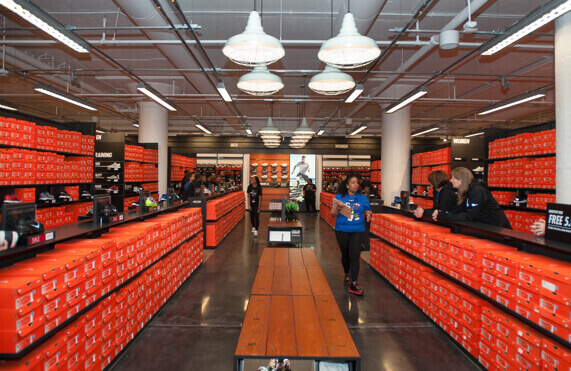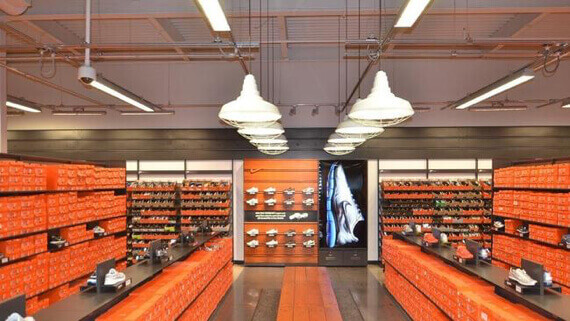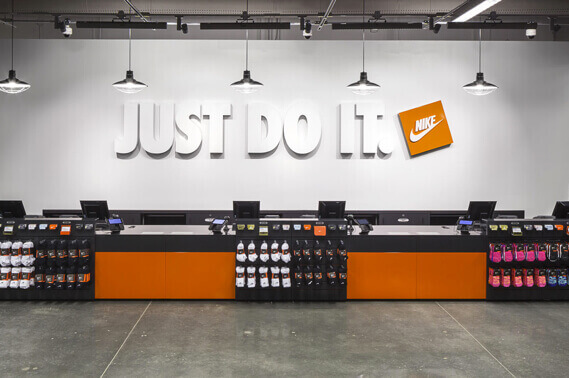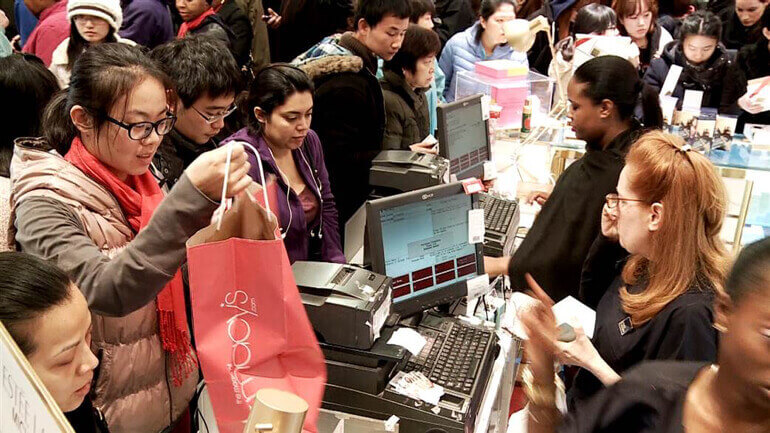Omnichannel Retail Guide Chapter 6
Omnichannel retail practices
What will be the next step of omnichannel in the future? Will it mean having a fully unified commerce platform that delivers what customers demand in any way, across all channels and devices?
Let’s see how three famous retailers in the world delivered these unique experiences.

Fraport (Fraport AG Frankfurt Airport Services Worldwide) is a German transport company that operates Frankfurt Airport in Frankfurt am Main and holds interests in the operation of several other airports around the world. In 2015, Germany’s Frankfurt Airport served 61 million passengers, making it one of Europe’s largest travel hubs.
But Fraport is not just a typical airport.
Fraport also develops another service—shopping service, called Fraport Store (or Frankfurt). With over 300 retail outlets, Frankfurt has become the biggest shopping mall in Germany.
“We were faced with the enormous challenge of transferring our business into the modern digital era. The solution brings a unique result for the travel and shopping industry.”
Kai Schmidhuber, Senior Vice President Fraport
Fraport omnichannel story
Omni awareness
Earlier, Frankfurt was just the biggest OFFLINE shopping mall. It could only serve customers who bought directly at the store.
To keep track of technology innovation, in 2013, Fraport opened ONLINE shopping.
Despite this change, Frankfurt realized that Online and Offline services still worked separately.
Online shopping only fitted with people who did not travel. The one who busily traveled would scarcely use this service, while travelers were potential customers to Frankfurt Stores at the airport.
Thus, Frankfort began to aim to maximize the commerce potential of its millions of visitors.

“Frankfurt is one of the busiest transit hubs in the world. We see a lot of passengers coming from an international destination and leaving us for another international destination. Those passengers are also very enthusiastic consumers. Take our Vietnamese passengers, for example. They spend eight times more than the average passenger in our terminal.”
Kai Schimdhuber – SVP of Multichannel at Fraport
To reach their goal, Frankfurt needed to change. This would not be just a renovation but a breakthrough revolution to innovate the way people experienced airports by connecting every aspect of travel from the airplane, to the ticket counter, to the shopping, and beyond.
In a nutshell, Frankfurt wanted to go beyond the usual customer demands.
First step to omni revolution
Many people said Frankfurt was a daydreamer. “Are they only daydreaming?”
In 2016, Frankfurt has proved to the world that Frankfurt was a great “daydreamer” who turned dreams into reality. And how Frankfurt could make the miracle?
Omnichannel is the ultimate key.
Frankfurt successfully performed one of the omnichannel retail best practices.
They delight consumers with the omnichannel retail experience: they can buy online from the plane or on their way to the airport, as well as pick up, ship, or deliver from the store to any location within the airport or off-airport.
A unique new omnichannel retail concept simplifies seamless on-and-offline shopping for passengers.
Platform cross-links travel information, services, local stores, and online shopping.
As a result, the omnichannel technique has led Frankfurt to a new “unbelievable” achievement.
Dealing with newly-arising problems
Unfortunately, when Fraport had not celebrated their achievement yet, a new serious problem came out—their inventory management system was in trouble.

Fraport’s staff could not handle the number of products in all 300 retail outlets.
Sometimes, when a product in one store was out-of-stock, customers would be unable to buy that product, which dissatisfied huge numbers of customers.
However, other Fraport stores still held many items of this product. Moreover, these stores were in danger of overstock. That was a massive loss.
Since then, Fraport’s Managers began to think about multi-warehouse management.
Besides, they ran into another issue. With plenty of stores around the world and only 3,000 global employees, they could not keep track of product flow.
Inventory workers often mistook the numbers of products for physical stores and online delivery. Sometimes this issue led to low stock or out-of-stock in a few warehouses in the same country.
What they needed to solve were better management of stock Adjustment, stock transfer, stock alert, and especially forecast supply.
Another problem: Sometimes employees met trouble with language conflict on the platform.
Besides, because of the complicated UI/UX design of their old warehouse management software, employees also felt hard to understand plenty of buttons on the management software.
In general, for its bold omnichannel vision, Fraport really needed to orchestrate hundreds of stores, drop-shippers, warehouses, and third-party logistics companies to present a unified experience to travelers.
To achieve its goal, Fraport combined the flexibility of the Magento commerce platform with the robust Magento Commerce Order Management solution, to begin connecting their retail outlets.
“You’re dealing with a lot of companies who have their own IT systems…and they all needed to be part of one common solution. We had to create multiple layers to encompass [everyone’s needs], one of them being a PIM solution that the retailers use to either upload their own product, if they don’t have their own ERP system, or that directly speaks to [their own ERP systems].”
Kian Gould, Fraport’s Strategy Advisor
Fraport applied vast open source expertise to implement additional systems, including a retail portal where retailers can easily manage their brand and customer experiences themselves. This was made possible by an integration layer (ESB) that connects various on-premise systems, OMS systems, and real-time business intelligence systems.
As a result, Fraport solved problems in the blink of an eye and became one of the omnichannel best practices. Stock management had become easier than ever.
Employees could effectively control stock transfer between each store, each warehouse, and even each country.

Amazing success
“What really special about this solution is that it’s one of the first true multi-retailer, multi-channel, multi-everything solutions you can use across a variety of platforms.”
Kian Gould, Fraport’s Strategy Advisor
Fraport successfully changed the way people used to think about shopping. Nowadays, Frankfurt Airport is leading to become one of the world’s most innovative travel and retail centers.
Its omnichannel practice spans more than just owned channels like stores, kiosks, online and mobile—it integrates retailer inventory and fulfillment across partners and channels it doesn’t directly own.
Each among millions of travelers can possibly become potential customers, even when they’re still in transit.
Lesson

#1: Fast Awareness with the changing of market
Fraport’s managers understood that they could not develop their shopping service at the airport if they did not start to make a change for their business.
After they had changed to eCommerce, they did not rest on their laurels. They kept forecasting the shopping trend and planning the best ways to satisfy more potential customers and create a new mindset for customers.
That’s why they developed online services and changed from single channel to omnichannel.
#2: If you want to go fast, improve your salers. If you want to go far, improve your Inventory
After changing to omnichannel, their conversion rate increased significantly.
However, they faced a new problem, they could not handle correctly all the quantity and transformation from their warehouses. Inventory management helped them control all the stock amounts, gain more customers, and significantly increase their business incomes.
By this, Fraport has become a successful omnichannel retail case study.
Nike

Nike is a sportswear and equipment supplier based in the United States. The company was founded in January 1964. Now, it is one of the fastest growing and globally respected brands.
Nike is not only engaged in the design, development, manufacturing, and worldwide marketing but also sales of footwear, apparel, equipment, accessories, and services.
Nike, an American multinational corporation, never stands outside any retail trends. This company is also solely concentrated on innovation to fully satisfy their consumers.
In 2017, Nike operated a total of 1,142 retail stores throughout the entire world. It can be said that they are a big retailer having lots of goals to reach, thus, they have applied an Omnichannel system to develop their system and attract more customers.
Among our omnichannel practices list, Nike has implemented a great backend management system for their omnichannel strategy.
Due to the discrepancy database from inventory, Nike Inc. could not control large numbers of items.
Nike chose omnichannel as a strategy for re-arranging the inventory system, which then led to a seamless shopping experience for Nike’s customers and incredibly boost its profits.
Nike omnichannel story
Why Omnichannel Retailing?
The more stores Nike opened, the higher demand customers asked for Nike products. This led to an issue—if it wanted to grow, it had to focus strongly on their inventory management to provide products rapidly and bring a seamless shopping experience.
It also meant that Nike needed to re-arrange all the warehouse systems, in other words, “tidy up” the chaotic inventory system.

Discrepancy database
In 2000, Nike had trouble with its new ERP software when it did not fit with their inventory management system and resulting in Nike losing around $100 million in sales.
Nike had faced difficulties with their inventory and scheduling of shipment.
Their data software sometimes displayed data errors or bugs, which mistook how much quantity each location should receive.
It led to frustrating problems for warehouse managers.
For example, at the Jersey Shore location, because warehouse staff could not ensure how many items they would get, many cartons often got lost and ended up reappearing on the next shipments truck with a bundle of other cartons, making the process of storing inventory difficult for the staff.

The discrepancy in inventory also became costly, as well as waste in profit.
If these lost cartons would show up on time, Nike locations would have a better handle on managing their inventory. They would also benefit from this for the following shipments that were planned to arrive.
To sum up, Nike Inc. understood that Nike’s inventory issues would be to reevaluate their inventory management software and make sure it was working correctly, based on location.
If the software wasn’t working properly or efficiently, Nike should switch their system and adapt to different software or hire an external partner to assist.
Thus, what they needed was a solution to easily manage and keep updated.
Nevertheless, if the software was working properly then the issue might be with the trucking company or the distributors. Solving this inventory issue would ultimately decrease overproduction, and increase Nike’s productivity as a whole.
Besides, despite the fact that Nike’s problems had not been solved yet, they got a big goal.
Christian Shi, president of direct-to-consumer, told Internet Retailer: “Nike plans it will grow total sales to $50 billion by 2020, meaning e-commerce will account for nearly one-third of the company’s overall growth. Nike will accomplish that digital feat with a three-pronged strategy.”
So which solution could both solve their issues and help them reach their goal?
Omnichannel was the ultimate answer.

Use centralized data to improve inventory management
The objective of this omnichannel strategy was to maintain operations management that minimizes inventory costs while maximizing its effectiveness and efficiency.
To implement a successful omnichannel practice, Nike’s operations managers applied the perpetual method of inventory management, which involved continuous monitoring and movement of inventory from the supply chain distribution and retailers.
They were in the process of integrating all their information into a single shared platform.
The single shared platform, according to Koch (2004), was expected to improve the overall operation of the company among others. Thus, it brought several motivations to their system.
There would be improved financial visibility, accurate projections and forecasting, and better reallocation of the company’s resources.
Mongelluzzo (2002) explained that Nike would be able to achieve the key of the supply chain strategy which is having up-to-date information which would, in turn, play a key role in ensuring that the supply chain was more efficient than ever.
The omnichannel retail technology was utilized at Nike with a process including:
According to a post by Retail Technologist Alex Senn on LinkedIn, it took a deep dive into the Nike omnichannel experience. He mentioned:
- Central warehouse/vendor management system
- Inventory management system centrally connected with store and warehouse availability
- Website to handle orders and distribute proper order details for warehouse
- Personalized CRM for detecting past purchases
- In-store mobile-based POS
Nike integrated their digital properties with physical stores, making it easy to find out information about a particular pair of shoes online.
Furthermore, Nike takes advantage of showrooming by offering an exclusive line of shoes that while displayed in the store can only be bought online using the NikeID program.
Staff uses handheld POS systems to accept payments, process returns, and arrange home delivery without making customers queue up at the entrance.
Nike can use the data collected in-store, online, and on mobile to make the shopping experience even more personalized.
For example, if you bought a pair of shoes from the store, Nike can email you a discount coupon for a special occasion or something like that a day later, or send you a mobile push notification for the same.
Customers can pick orders anywhere, anytime and anyhow
You can buy a Nike product online and pick it up at a store. You can also buy in-store, and get it delivered home, or order something and pick it up from another store.
This brings out the best practices in omnichannel retail.
“When you shop at Nike, or at Nike.com, you'll notice that you can shop anywhere and have the product show up anywhere you'd like. I'm referring to buying online, picking up in store or buying in store and receiving the product at home, or simply having it ordered and ready at another store.
Whatever the case may be, the omnichannel retail system being utilized is ready to provide any product Nike carries, anywhere the consumer could possibly want it to be. This really is what consumers expect now.If you think about what this is from a technical perspective, it is simply one common database, with parameters to edit which locations the product is on hand, and which locations to ship the product too. It is not overly complicated, and yet many retailers are STILL missing this point.
While Nike may have put a few million dollars into the entire customized system, you can have the same ability to operate across channels with Epic Commerce. This is not hard to implement, or have someone implement for you, and will give you the same functionality across any channel you prefer to operate through while letting you manage it all from the comfort of any device.”
Alex Senn, Retail Technologist
Additionally, Nike offered a vast variety of products, from all different types of athletic shoes (running shoes, cleats, etc.) to workout gear and regular apparel. And they had their way to run a wide assortment of services/products efficiently.
Nike handled its inventory by using specific software. Nike’s inventory management software helped predict which items will be more popular and sell more and comes up with an estimated amount of supply to meet the predicted demand.
The software came up with these figures mostly based on the previous year’s sales. Once the program produced the demand forecast, Nike then prepared a manufacturing plan.
And, the results Nike achieved were…
“New Inventory Management, New Triumph Sales”
This leads to broadening the scope of innovation with two outstanding things: Reduce inventory cost and increase inventory efficiency.
- Reduce inventory cost
- Increase inventory efficiency
- Fourth quarter revenues up 5% to $8.7 billion; 7% growth on a currency-neutral basis
- Fourth quarter diluted earnings per share increased 22 percent to $0.60
- Fiscal 2017 revenues up 6% to $34.4 billion; 8% growth on a currency-neutral basis
- Fiscal 2017 diluted earnings per share increased 16% to $2.51
- Inventory efficiency up 4% as of May 31, 2017 (compared to May 31, 2016)
– Nike Report 2017 –
Therefore, with Nike’s omnichannel practices, shoppers spend 50%-300% more than single-channel shoppers. It makes Nike’s revenue per customer increase.
Besides, 26% of consumers are actively seeking personalized offers, and Nike gets more loyal customers who would return to buy more over time.
In a nutshell, in this successful omnichannel retailing example, Nike and Omnichannel is a win-win relationship for both customers and brands.
Lesson

#1: Synchronize and centralize data
With the use of data exchange technology in the distribution channel system, Nike gradually demonstrates the effectiveness of the order process.
Nike has synchronized all its information into one shared platform, which is expected to improve the overall operation of the company among others.
#2: Determine the “strong” inventory management is one of the competitive advantages.
Nike’s inventory management perspective is a strategic part of the company. Therefore, Nike has identified, built, and developed the inventory more closely and effectively.
By investing millions in creating the best omnichannel practices, Nike was eager to reduce the time it takes to receive an order until the final product is delivered to the retailer.
Moreover, this investment should help Nike respond quickly to customer demand.
#3: Implement good omnichannel strategy to improve brand image and create customer’s loyalty
From Nike’s successful omnichannel practices list, increasing customer shopping experience through omnichannel can be considered a lesson that is worth learning for other retailers.
Because satisfying customer demands from A-Z not only helps your business boost sales but also improves brand value, as well as builds loyalty to customers.
Macy’s

Established in 1858, Macy’s is an iconic retailing brand with nearly 800 stores operating coast-to-coast and online at macys.com.
Macy’s offers powerful assortments and the best brands, tailored to each and every customer with obvious value, engaging service, and unforgettable moments. Its famous flagship located at Herald Square in New York City is known as the “World’s Largest Store,” with over 1.1 million square feet of retail space.
Macy’s has a clear vision to help customers shop anywhere, anytime, and anyhow they choose i.e. typical omnichannel strategy examples. . To make that vision a reality, inventory accuracy is a critical component of the initiative. Macy’s executes on its corporate strategy dubbed M.O.M:
- My Macy’s merchandise assortments
- Omnichannel integration
- Magic Selling customer engagement
In this example of omnichannel retail best practices, a big retailer – Macy’s lost a huge amount of money during a year although they used omnichannel with a highly planned strategy.
After this failure, they realized that they underestimated inventory management.
This case study would show you how they employed and upgrade omnichannel performance, especially inventory system to improve their sales higher.
Macy’s omnichannel story
Big mistake when adopting omnichannel practices
In 2013, Macy’s met a serious problem with inventory accuracy.
They could not control the product flow in each warehouse. The inventory degradation occurs at a rate of about 2-3% a month, which could equate to 24 percent by the end of the year.
This would make omnichannel sales challenging, especially if only one or two units of a particular product were reported to be located at a store.
“You don’t want to make decisions based on bad data.”
Peter Longo, Macy’s President of Logistics and Operations
Macy’s focused too much on sales and customer services without noticing the inventory management. Merchandise movements, administrative errors, and system updates were terribly detrimental to the fulfillment process.
With thousands of product categories across all 800 stores and the paramount number of customers, all Macy’s actions and omnichannel strategies must strongly focus on providing localized merchandise offering to bring a smoothly endless shopping experience.

Explore a new door in omnichannel strategy
Customize their inventory management—upgrade traditional tool RFID
In 2008, Macy’s applied RFID (radio frequency identification) separately to their inventories. Macy’s omnichannel best practices actually started in 2015, after their “inventory failure”.
Macy’s began to utilize RFID by integrating RFID across all of its warehouses. With item-level RFID, Macy’s could focus on assortment and service while using their existing inventory to address fulfillment demands.
As a result, Macy’s Inventory Visibility increased 4 times.
Apply RFID to its latest strategy “Pick to the Last Unit”
In the past, the last item in inventory used to be a great fear for retailers. Inventory counts were simply not accurate enough to ensure that the last unit of a particular product was actually in stock or available for sale.
When an item falls below a minimum amount, the item would be “out-of-stock” and unavailable. However, Macy’s turned this fear into sales.
The program, Pick to the Last Unit (P2LU), enabled the retailer to list goods for sale online even when there was only one such item available at the store.
RFID allows omnichannel fulfillment of consumer purchases, right down to its last available unit of in-store merchandise. The last unit of an item in any store can be easily located and made available for sale.
Thanks to the inventory accuracy and visibility, Macy’s conducted an analysis of how much inventory exists in each store when there is only one unit left – the hardest to be found and sold.
“About 15 to 20 percent of your inventory is accounted for by the last unit in the store. It’s a massive amount of budget, either marked down or not sold, and it is curable through RFID. The confidence to sell is enhanced by RFID. That’s why we are aggressively pursuing this concept of ‘Pick to the Last Unit’ because we know it’s there.”
Peter Longo, Macy’s President of Logistics and Operations

Let’s take an example to make this clear. If Macy’s had the last item of Louis Vuitton bag priced at $5,000, they still could show it available in any online stores and serve it to any customers.
In case, a customer wanted to buy 2 similar bags at the same time, Macy’s could contact the supplier to bring directly 2 bags for its customer.
Besides, the accuracy of RFID also helped Macy’s to inactive “Supply Forecast” and precise “Low-stock Alert”, which meant that before the product quantity dropped to the last item, they would immediately ask the supplier to bring more items to them.
Shipping in a blink
Besides, as they had spent more than 2 years analyzing customer behavior, Macy’s noticed that before visiting a store, its customers regularly check products on macys.com to save time choosing at the physical store.
Thus, the in-store available product visibility would be helpful for online customers.
To achieve near-real-time inventory visibility for all its stores, the company had to integrate legacy systems and build a new and robust order management system. This system incorporates fulfillment optimization algorithms based on products and its business model.
Online customers can now access their closest store with the item in stock. They can also select their preferred delivery options – such as click-and-collect at a nominated store, or home delivery.
If the customer orders a product that is currently unavailable in a Macy’s store but available from a nearby supplier, the item is dispatched directly from the supplier to the customer as this reduces the turnaround time.
This model requires visibility of supplier inventory and better collaboration between the retailer, its suppliers, and its logistics provider.

Amazing success
After all, in the success of their omnichannel retail best practices, Macy’s reduced $1B of inventory from its stores and reduced inventory costs by lowering interim inventory requirements by one-third.
To test the P2LU strategy, Macy’s conducted a pilot project with women’s dresses which yielded highly impressive results. While online sales were up, pilot stores’ fulfillment sales had significantly increased compared to last year. That was a drastic improvement.
Macy’s recognized that leveraging single unit inventory— approximately 20% of inventory represented at the single unit level by location—can help drive sales and margin.
Inventory accuracy can leverage every unit in every store to fulfill orders. It also enables Macy’s to focus on assortment and service while using existing inventory to address customer demands.
As a multi-faceted retailer with a smart combination of stores, online presence, technology, and business capabilities, Macy’s is committed to helping its customers shop anywhere, anytime, and anyhow they choose, by leveraging the entire inventory of the company to satisfy demand.
Lesson
#1: Never underestimate the efficient inventory management
Macy’s had put a strong focus on sales and ignored inventory management. Only after the serious loss by inventory degradation did they begin to think about how to manage inventory efficiently.
This not only created a huge loss for Macy’s but also took a great amount of money to improve the inventory system as soon as possible.
#2: Apply what you had on what you use
Macy’s got the best inventory supporter – RFID. However, they had considered RFID as a supporter for separate warehouses. After Macy’s synchronized RFID across all inventories, productivity significantly increased.
The accuracy of the new RFID also helped Macy’s to accomplish its unique strategy “Pick to the last unit” to reduce loss completely and satisfy customers’ demands.
All in all, there are many ways to provide the real-time, seamless order fulfillment and inventory management needed to deliver a satisfying frontend omnichannel experience. The best practices of omnichannel retailing from Fraport, Nike, and Macy’s are not the specifics of how they aligned their backend, but that they made sure how to implement properly.








